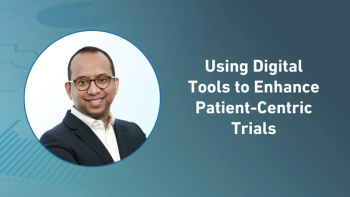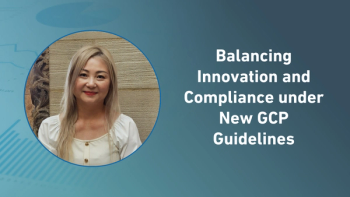
- Applied Clinical Trials-11-01-2021
- Volume 30
- Issue 11
The Answer to Streamlined Clinical Trials
Cloud-based clinical metadata repositories can aid in accelerating clinops.
This article explores how the latest all-in-one, cloud-based clinical metadata repositories (CMDRs) and study automation platforms can be used to help clinical managers set trials up quicker, observe early results, and ensure that metadata is available in a format that meets regulatory standards.
Accelerating safe and effective clinical trials starts with metadata—the building blocks that define the trial and ensure standardized and compliant data collection. By reusing approved metadata, managers can quickly design trials that are optimized to deliver regulatory-submissible data. This means that trials can start faster and, when less data rework is needed, early insights can be gained, facilitating flexible processes, and improving safety.
Clinical trial metadata management systems are often evolved from an integration of processes, workflows, and repositories, and are added to as businesses grow or merge. Disparate legacy systems can cause team members to operate in siloes, and as new systems and technology are onboarded, integration can be difficult, requiring manual workarounds. Just finding the required datasets can be challenging as they can be stored in many different formats and files, as well as on separate servers.
As organizations worked to digitize studies and make use of electronic data capture (EDC) systems and electronic case report forms (eCRFs), many introduced processes with multiple manual steps. In the modern clinical trial, this may translate into several manual builds in different EDCs, each time-consuming, and at risk of errors that can result in hours of rework.
Then, there is the matter of compliance. When metadata files are held disparately, it can be hard to create a single source of record to ensure that the resulting clinical trial data outputs meet the requirements set by the Clinical Data Interchange Standards Consortium (CDISC).1 Non-compliant data outputs run the risk of rejection by regulatory bodies or requiring rework, a task that adds considerable time at the end of a lengthy trial.
Since new versions of CDISC standards are released frequently, and CDISC Controlled Terminology is updated quarterly, keeping abreast of new developments is critical. To do so, organizations may need dedicated internal experts or external assistance to monitor the regulatory environment and implement any necessary updates to metadata management systems. When these revisions coincide with other organizational and clinical trial protocol adjustments, change control becomes a risk. Any amendment to metadata management systems will have an impact on other assets, data outputs and future study builds. And when the impact of these system changes cannot be anticipated, it can be difficult to make an informed and educated decision about how and when these updates should take place. Approval procedures can reduce this risk but, when email chains are involved, this can waste valuable time.
It can be tempting to bring more technology in to help deal with each individual issue, but often this can add to the problem, causing greater integration issues and perpetuating the silo mentality.
A positive view on standardization
To address some of the issues raised by pharmaceutical organizations and regulatory bodies around the regulatory review process, CDISC was established to help standardize data submitted for approvals. Standards were established not just for data tabulation and analysis by regulatory bodies, but also for the planning and data collection elements that are completed internally. This interoperability between the planning, build and outputs of the clinical trial process aims to expedite the regulatory review process, while also helping reduce the amount of time and effort that all stakeholders spend making sense of unstandardized data.
CDISC standards are now required by the US Food and Drug Administration (FDA) and the Japanese Pharmaceuticals and Medical Devices Agency (PDMA), as well as being the preferred standard for electronic data submission to the National Medical Products Administration (NMPA) in China.2
Although the planning and data collection elements of CDISC are not requirements, they are necessary steps to define the studies in common terms, establishing a standardized study design and providing the basis for creating consistent CRFs as shown in Figure 1 below.
The regulatory requirements are related to standardization of the structure and format of submissible data, including:
- Standard for Exchange of Nonclinical Data (SEND)—non-clinical data structured for submission.
- Study Data Tabulation Model (SDTM)—clinical data structured for submission.
- Analysis Data Model (ADaM)—analysis datasets generated from SDTM data.
- Define Extensible Markup Language (XML)—metadata format describing the content and structure of the SEND, SDTM and ADaM datasets.
- National Cancer Institute (NCI) controlled terminology3—consistent language used to clarify all terms in collected data.
CDISC compliance can often be seen as a necessary evil, or even a box to tick on the road to regulatory approval. However, that is only true when data is reworked to comply with CDISC as an afterthought, rather than designed into the trial from the outset, thereby increasing the time and costs attributed to clinical trials. Using CDISC as a strategic tool can help organizations to find the fastest path from trial set-up to data submission, by creating pre-approved data collection tools that deliver automated, compliant metadata.
Creating submission-ready data brings additional benefits too, as sponsors gain an early first view on a trial’s progression. In adaptive design clinical trials, early indications can allow in-trial adjustments, reallocation of drug products, and even trial stoppages, where adverse events are observed that could put patient safety in jeopardy.
Cloud-based CMDRs
All-in-one, cloud-based CMDRs provide a central focus for change. They allow organizations to embrace the built-in CDISC compliance has to offer, and help connect the disparate metadata siloes present in clinical trial design. A CMDR is a central hub of information. It’s a single source of record for all metadata relating to clinical trials, including forms, annotations, terminologies, and files. With cloud-based access, anyone, with the necessary permissions, from any location can access metadata to design and visualize eCRFs and build EDCs. Additionally, all-in-one functionality drives automated protocols, removing the risk of errors related to manual activity, and integrating disparate systems and siloed information. As shown in Figure 2, these features combined enable CMDRs to provide visibility, governance, and collaboration between all stakeholders.
Organizations may have already invested in technology to resolve individual issues such as clinical metadata storage, standardization, or study automation, and it can be tempting to plug each problem with workarounds or temporary fixes. However, this point solution-based approach can distract people from tackling the overall bigger picture issues. These cloud-based CMDRs on the other hand, represent a long-term, system-wide solution. They enable system integrations and facilitate lasting changes that drive clinical trial efficiencies and solid return on investment.
Ideally, a CMDR should be a fully integrated system—or a hub that centralizes metadata, enables access, manages standards, and provides the mechanisms for controlled change. As shown in Figure 3 below, the CMDR should communicate with existing systems via plugins or application programing interfaces (APIs), allowing data exchange and making use of existing familiar platforms and workflows, thereby reducing the amount of user training needed.
The easy access that cloud-based systems provide should not be confused with control. CMDRs should be secure, allowing changes to be requested and passed through a thorough, electronic process before being accepted. Some systems allow users to create a customizable metadata lifecycle, meaning all stakeholders can see exactly which state a standard or study is in (i.e., draft, in progress, in review or approved) and only perform the actions allowed at that stage. Additionally, being able to model metadata adjustments before acceptance– including standards updates– can provide a full impact analysis of the resulting changes on all parts of the trial and connected studies before implementation.
Finally, CMDRs should offer design templates with CDISC standards embedded within their structure, ensuring all trials are built with regulatory submissions in mind. When CDISC standards are used to standardize the structures for collecting and submitting data and NCI Controlled Terminology is used to ensure semantic consistency across trials, regulatory bodies can quickly locate, view, and analyze data making the review process much more straightforward.
Next stage benefits
CMDRs can be a key to fully embracing the strategic benefits of CDISC compliance and standardization. But, by creating end-to-end metadata traceability, consistency and reuse potential, they offer much more. By embracing this new technology, organizations can increase metadata quality and consistency, expedite trial setup, and speed up data outputs.
The latest CMDRs also provide the capability to design and preview eCRFs without having to build the EDC. The eCRF can be fully visualized, interrogated and refined before embarking on EDC creation, ensuring a right-first-time approach. For more complex trials, multiple EDCs can be built from the one CMDR directly from the specification, further reducing trial setup times and removing the errors associated with manual creation from external spreadsheets
or forms.
By designing standardization into the trial and automating SDTM outputs, organizations can produce submission-ready data without the manual rework needed to meet regulatory requirements.
While there has been a lag in implementation of these platforms, another driving force is that CDISC standards are now required by several regulatory authorities and the CDISC 360 project is already underway to build on the existing standards and enable end-to-end automation of study specification and data processing.4 As CDISC standards continue to be updated, organizations will benefit from understanding how they can be incorporated into their processes to drive efficiency improvements, with CMDRs as an enabler.
The challenges that hinder the implementation of CMDRs today will be magnified in the future if organizations continue to resist change. Siloed datasets and manual processes need to be fixed and legacy systems need to be connected. But when these problems are left to fester, they grow. As the number of clinical trials increases and researchers respond to the needs of a growing and aging population, pharma, biopharma and CROs will need to run faster, more efficient, and more cost-effective trials to compete in this space.
Put simply, investing time at the outset by implementing an all-in-one, cloud-based CMDR can deliver many long-term benefits. This technology promises a future of even greater potential as more APIs feed in and out of safety platforms, EDCs, third-party platforms, and internal databases. With the inclusion of clinical trial metadata in semantically rich formats—including from non-traditional devices such as wearables—the industry should realize an abundant source of insight. CMDRs will play a central role in organizing and standardizing this data to extract real-world meaning. With a focus on creating a central hub for clinical metadata, organizations are set to benefit from the collaboration, reuse, compliance, and consistency that CMDRs bring to power trial improvements.
References
https://www.cdisc.org/ visited on 25 May 2021.https://www.cdisc.org/resources/global-regulatory-requirements visited on 26 May 2021.https://ncit.nci.nih.gov/ncitbrowser/ visited on 25 May 2021.https://www.cdisc.org/cdisc-360 visited on 26 May 2021.
Gilbert Hunter, Customer Success Manager, Formedix
Articles in this issue
about 4 years ago
Currency of Patient Engagement: Changing Tidesabout 4 years ago
Biopharma-Academic Collaborations in 2021about 4 years ago
Addressing Digital Trialsabout 4 years ago
Taking DCTs to the Next Levelabout 4 years ago
A New Era for Translational Researchabout 4 years ago
Applied Clinical Trials November 2021 Issue (PDF)about 4 years ago
European Drug Repurposing: An Updateabout 4 years ago
Increasing Adherence With Dosing Remindersabout 4 years ago
FDA Acknowledges Hurdles in Utilizing Real World Dataover 4 years ago
Accelerating Research Site OperationsNewsletter
Stay current in clinical research with Applied Clinical Trials, providing expert insights, regulatory updates, and practical strategies for successful clinical trial design and execution.




